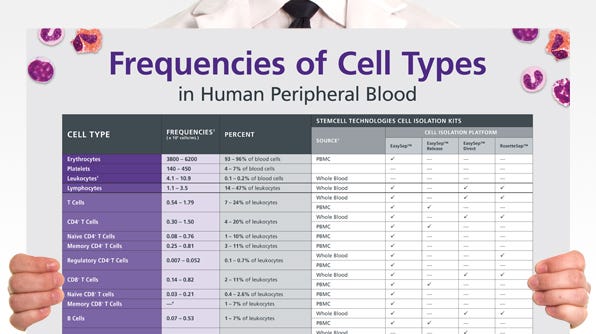Inflammatory and Autoimmune Diseases
Inflammatory and autoimmune diseases are often caused by genetic and environmental factors that give rise to aberrant immune responses. Controlling host immune responses without eliminating the ability to control infections is crucial to managing these diseases.
Below is a collection of scientific resources for your inflammatory and autoimmune disease research.
Frequencies of Cell Types in Human Peripheral Blood
This wallchart provides a list of the frequencies of cell types in human peripheral blood, as well as the column-free cell isolation kits available for each cell type.
Get Your Free Copy >-
 How EasySepÔäó Magnetic Cell Separation Technology Works: Fast and Easy Cell IsolationEasySepÔäó technology, a fast and easy immunomagnetic cell separation technology that allows you to isolate virtually any cell types from a variety of sample sources in as little as 8 minutes
How EasySepÔäó Magnetic Cell Separation Technology Works: Fast and Easy Cell IsolationEasySepÔäó technology, a fast and easy immunomagnetic cell separation technology that allows you to isolate virtually any cell types from a variety of sample sources in as little as 8 minutes -
 Considerations for Flow Cytometry GatingTo achieve accurate results, it is important to use an optimal gating strategy when assessing cell samples via flow cytometry
Considerations for Flow Cytometry GatingTo achieve accurate results, it is important to use an optimal gating strategy when assessing cell samples via flow cytometry -
 Using Cell Density Gradients to Optimize Your Cell IsolationsRosetteSepÔäó, a unique immunodensity cell isolation platform, isolates highly purified cells by density gradient centrifugation without columns or magnets
Using Cell Density Gradients to Optimize Your Cell IsolationsRosetteSepÔäó, a unique immunodensity cell isolation platform, isolates highly purified cells by density gradient centrifugation without columns or magnets -
 Cell Isolation Directly from Whole Blood without RBC Lysis or Centrifugation: EasySepÔäó DirectIntroduction to the EasySepÔäó Direct immunomagnetic cell separation platform
Cell Isolation Directly from Whole Blood without RBC Lysis or Centrifugation: EasySepÔäó DirectIntroduction to the EasySepÔäó Direct immunomagnetic cell separation platform -
 Selecting a Protocol on the RoboSepÔäó-SBasic overview on how to use and maintain your RoboSepÔäó-S; steps involved to select a cell separation protocol
Selecting a Protocol on the RoboSepÔäó-SBasic overview on how to use and maintain your RoboSepÔäó-S; steps involved to select a cell separation protocol -
 William Housley, PhDDr. William Housley describes his work studying the genetic basis of autoimmune diseases, including multiple sclerosis and Crohn's disease
William Housley, PhDDr. William Housley describes his work studying the genetic basis of autoimmune diseases, including multiple sclerosis and Crohn's disease -
 Fumio Takei, PhDDr. Fumio Takei describes his work studying the role of NK cells and ILC2s in allergic inflammation
Fumio Takei, PhDDr. Fumio Takei describes his work studying the role of NK cells and ILC2s in allergic inflammation -
 How to Prepare a Single-Cell Suspension from Primary Tissue Samples (e.g. Mouse Spleen)How to harvest cells from a mouse spleen and prepare a single cell suspension prior to performing cell isolation to enable cell separation by minimizing additional cell loss and improving the labeling of target cells
How to Prepare a Single-Cell Suspension from Primary Tissue Samples (e.g. Mouse Spleen)How to harvest cells from a mouse spleen and prepare a single cell suspension prior to performing cell isolation to enable cell separation by minimizing additional cell loss and improving the labeling of target cells -
 How to Isolate Cells with EasySepÔäó Column-Free Cell Separation TechnologyIsolation of human CD4+ T cells by negative selection using EasySepÔäó to separate highly purified cells in as little as 8 minutes
How to Isolate Cells with EasySepÔäó Column-Free Cell Separation TechnologyIsolation of human CD4+ T cells by negative selection using EasySepÔäó to separate highly purified cells in as little as 8 minutes -
 Modeling Alzheimer's risk using human TREM2-knockout microgliaAmanda McQuade from Dr. Mathew Blurton-JonesÔÇÖs lab discusses her protocol for differentiating microglia from induced pluripotent stem cells (iPSCs) and the use of these microglia in vivo and in vitro to uncover the mechanisms of immune activation and neurodegeneration in AlzheimerÔÇÖs disease.
Modeling Alzheimer's risk using human TREM2-knockout microgliaAmanda McQuade from Dr. Mathew Blurton-JonesÔÇÖs lab discusses her protocol for differentiating microglia from induced pluripotent stem cells (iPSCs) and the use of these microglia in vivo and in vitro to uncover the mechanisms of immune activation and neurodegeneration in AlzheimerÔÇÖs disease. -
 Isolate Multiple Cell Types from a Single Sample with Sequential IsolationSequential separation, for higher recovery of purified cells from limited sample size and isolation of multiple cell types, is ideal for chimerism analysis
Isolate Multiple Cell Types from a Single Sample with Sequential IsolationSequential separation, for higher recovery of purified cells from limited sample size and isolation of multiple cell types, is ideal for chimerism analysis -
 How to Isolate Nucleated Cells from Whole Blood Using HetaSepÔäó Erythrocyte Aggregation AgentHetaSepÔäó is an erythrocyte aggregation agent used to quickly separate nucleated cells from red blood cells
How to Isolate Nucleated Cells from Whole Blood Using HetaSepÔäó Erythrocyte Aggregation AgentHetaSepÔäó is an erythrocyte aggregation agent used to quickly separate nucleated cells from red blood cells

